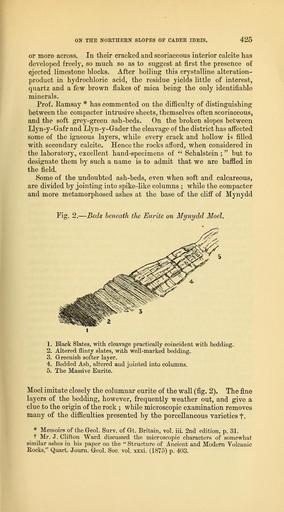MAKE A MEME
View Large Image

| View Original: | The_Quarterly_journal_of_the_Geological_Society_of_London_(13960434793).jpg (1166x2104) | |||
| Download: | Original | Medium | Small | Thumb |
| Courtesy of: | commons.wikimedia.org | More Like This | ||
| Keywords: The Quarterly journal of the Geological Society of London (13960434793).jpg ON THE NORTHERN SLOPES OF CADER IDRI8 427 <br> chloric acid a residue of dusky grey or colourless matter remains <br> In this some pumiceous particles may be made out ; but the oolitic <br> grains themselves leave a siliceous residue which no longer affects <br> polarized light although the concentric structure is retained It <br> will be seen how the discussion of the Liassic ironstone of Cleveland <br> by Mr Sorby and of the Northamptonshire ores by Prof Judd f <br> applies also to this older and more metamorphosed deposit <br> In connexion with Prof Judd's observations on the presence of <br> phosphoric acid in the greener varieties of the Northampton ore £ <br> we may remark that the ironstone of Cader Idris gives a distinct <br> reaction when treated with a nitric-acid solution of ammonic molyb- <br> date <br> Thus we are led to regard the oolitic structure in this ironstone <br> as original The carbonate of iron which in all probability replaced <br> the calcite or aragonite of the grains has now itself been broken <br> up leaving the cubes of magnetite as a residue The rock still <br> effervesces slightly when boiled in hydrochloric acid ; but the ease <br> with which its powder is attracted by the magnet shows that the <br> bulk of the iron is now in the oxidized condition The alteration <br> having taken place as a deep-seated process and not in contact <br> with the air neither haematite nor limonite has been developed A <br> specimen of the pisolitic ironstone of Pen-y-morfa near Tremadoc <br> for which we are indebted to Mr G J Williams E G S is still more <br> strikingly magnetic <br> If the iron-ore of Cader Idris was at one time a fairly calcareous <br> band among the more prevalent muds and shales it owes its preser- <br> vation to the pseudomorphic action that has gone on The very <br> marked proportion of carbonate of lime that occurs in the cavities <br> of the permeable rocks from Llyn Gwernen to the summit of the <br> mountain may have been in part derived from similar seams or shelly <br> patches the absence of which we have so frequently to deplore when <br> examining Ordovician or Cambrian strata It is unnecessary to <br> dwell upon the increased effect of solvent action when occurring <br> in a region subjected to pressure and earth-movement <br> On the east flank of Tyrau Mawr and above the mass of the <br> main eurite volcanic beds with slaty fragments recur at a height <br> of eighteen hundred feet fig 3 At this point the junction of the <br> tuff with the overlying normal slate is marked by a thin white band <br> consisting of granules of quartz and decomposed felspar ; it would <br> seem that this sand is a washed residue from the uppermost layers <br> of the tuff such as would be formed by the action of waves or <br> currents prior to the next sedimentation <br> Close to the foot of the Roman road where it descends in bold <br> zigzags from Craig Glas the talus is strewn with blocks of coarse <br> felspathic tuff which include wisps of shale more conspicuous than <br> those of Penrhyn-gwyn The dimensions of the surface here figured <br> Quart Journ Geol Soc vol xxxv 1879V Proc p 84 <br> t Mem Geol Survey Geology of Rutland pp 117-138 <br> Loc cit p 127 36940246 113696 51125 Page 425 Text 45 http //www biodiversitylibrary org/page/36940246 1889 Geological Society of London NameFound Idris NameConfirmed Idris EOLID 2720707 NameBankID 4204717 Biodiversity Heritage Library The Quarterly journal of the Geological Society of London v 45 1889 Geology Periodicals Smithsonian Libraries bhl page 36940246 dc identifier http //biodiversitylibrary org/page/36940246 smithsonian libraries Information field Flickr posted date ISOdate 2014-04-21 Check categories 2015 August 26 CC-BY-2 0 BioDivLibrary https //flickr com/photos/61021753 N02/13960434793 2015-08-26 05 55 34 cc-by-2 0 PD-old-70-1923 The Quarterly journal of the Geological Society of London 1889 Photos uploaded from Flickr by Fæ using a script | ||||